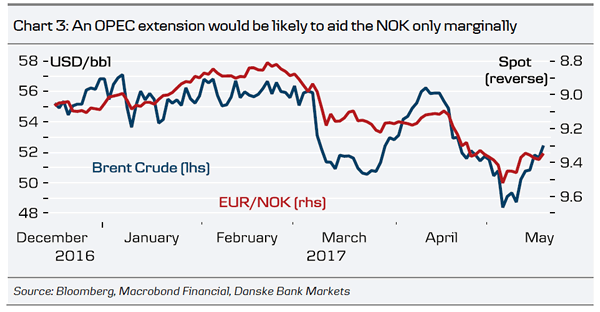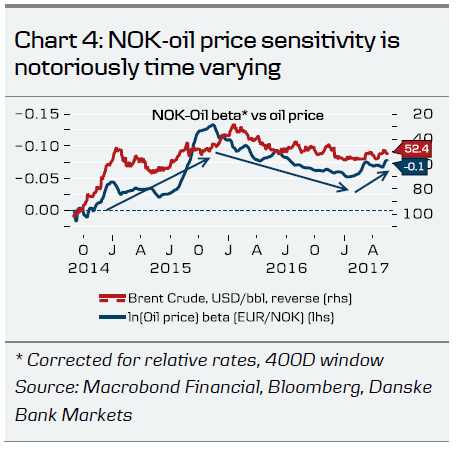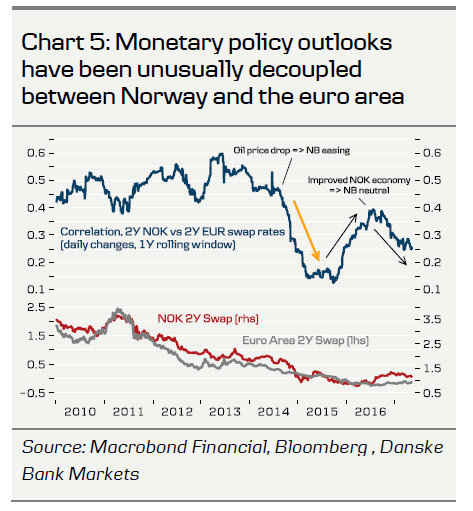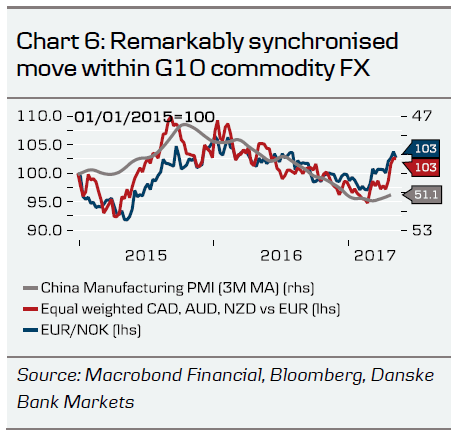- We look for Organisation of Petroleum Exporting Countries (OPEC) and non- OPEC supply cuts to be extended, with limited upside impact on oil prices.
- We expect Brent crude to trade around USD50-54/bl near term and rise to around USD60/bl in 2018.
- The NOK should benefit only marginally from an extension. Meanwhile, weaker global demand/the OPEC meeting pose downside risks to our NOK-forecasts.
- Strategy: Leverage funds should look to buy NOK strategically but tactically we prefer a side-lined stance. NOK volatility looks cheap. Corporates with long NOK (short FX) exposure should protect themselves against tail risk in the next 3M.
FX economics
Extension of supply cuts about priced
We expect the deal between OPEC and the 11 oil-producing countries outside OPEC to be extended when OPEC meets on 25 May. This has been more or less confirmed by recent comments, e.g. from Russia and Saudi Arabia, which have further hinted that the deal may be extended until March 2018. In our view, the market is about priced for an extension of supply cuts next week, although there is likely still to be some uncertainty about whether it will be for six or nine months. Positioning remains net long oil, which further backs our view and implied volatility at significant lower levels compared with 2016. Hence, if we are right that supply cuts will be extended, we see limited near-term price reaction and expect Brent crude to trade close to current levels (i.e. remain in the USD50-54/bl range). In the unlikely event the deal is not extended, we expect the price of Brent crude to fall to USD45/bl, which is close to the recent intraday low in May when markets priced out extension expectations. Medium term, we are still looking for the price of Brent crude to rise to around USD60/bl in 2018 on a lower USD and steadily rising demand. This is around 10-15% above current pricing in the oil forward market. In the big picture, supply cuts have had, and should continue to have, a limited impact on prices, while they have led to a shift of market share from OPEC and Russia to the US (see Charts 1 and 2).



Time varying NOK-oil sensitivity; failure would have larger effect
The NOK-oil connection is notoriously unstable. The time inconsistency is primarily down to (1) whether a given oil price change is supply or demand driven, (2) the size of the oil price move, (3) the direction of the oil price move, (4) the B/E thresholds of Norwegian oil projects and (5) other issues, e.g. dominating NOK/SEK flows. Generally, the connection has fallen steadily since the 2015-peak (Chart 4) in a move we think can be explained by all the factors above. In particular, cost cutting and margin compression have lowered B/E levels for key Norwegian oil projects, making economic growth less sensitive to oil price changes than was the case in 2014 and 2015. As a result, the amplified NOK effect of changes in the oil price via monetary policy has been much reduced relative to 2014-15 (see orange arrow on Chart 5).
Meanwhile, the NOK/oil price connection has risen recently (Chart 4). In our view, it comes down to markets repricing a more two-way risk in oil markets as last year’s OPEC and non- OPEC supply cut deal lifted the front-end of the oil forward curve while the longer end was kept in check by US shale producers looking to raise output. With the global business cycle turning over, the global demand outlook clearly paints a less upbeat near-term outlook for the oil price and commodity currencies than in 2016 (Chart 6). As a result, we think the NOK-oil price connection is likely to rise further in coming months, albeit not back to the 2015 high. According to our models, an oil price fall to USD45/bl (e.g. due to the unlikely event of no extension of supply cuts or a significant deterioration of global growth outlook – neither part of our base case) would send EUR/NOK c.18-22 figures higher.
FX outlook
EUR/NOK should fall only slightly on extension of output cuts
If our expectations materialise, a moderately higher oil price should aid support to the NOK and send EUR/NOK lower. Meanwhile, as an extension to the output cuts is about priced, the balance of risk for the NOK near term is asymmetrically skewed on the downside. An extension of supply cuts would lift the oil price only marginally, while weaker global demand outlook has started to exert downward pressure on oil prices. This suggests very moderate near-term NOK upside from the oil price even if the notoriously unstable NOKoil relationship has risen in recent months.
In 2017, we have emphasised the paradoxical situation of the NOK. On the one hand, the domestic story has not been as NOK positive for many years even if Norges Bank is unlikely to turn hawkish in June. On the other hand, global factors including the oil price are likely to remain challenging, limiting the near-term NOK upside potential. We forecast EUR/NOK at 9.30 in 1M, 9.30 in 3M, 9.10 in 6M and 9.00 in 12M (see FX Forecast Update: Cyclical risks surfacing as politics abate, 15 May), but emphasise that we see near-term risks to our profile skewed to the upside.
FX strategy
Tactically cautious despite long-term attractiveness
Leverage funds should look to buy NOK strategically but tactically we prefer a side-lined stance. According to our volatility valuation, NOK volatility looks cheap and, given the global business cycle outlook, we generally like long-vega strategies. Given the usual spot-volatility connection, we recommend entering 3-12M long NOK and vega strategies on dips in spot. Corporates with long NOK (short FX) exposure should use forwards in the coming three months and option structures that maintain a profit potential on a 3-12M basis. NOK based real-money funds should use dips in NOK to raise hedge ratios on foreign assets; not least on USD assets. Our NOK rates strategists see potential for a further cheapening of USD/NOK forwards on improved structural NOK liquidity
















